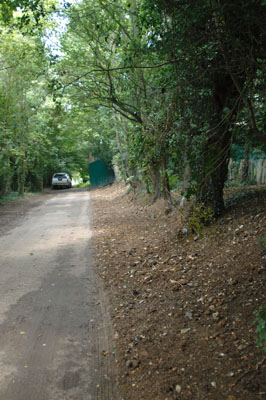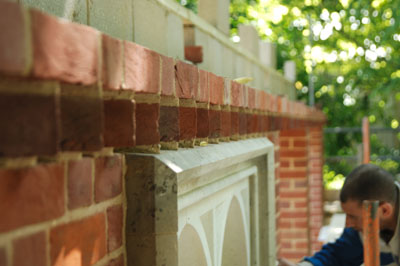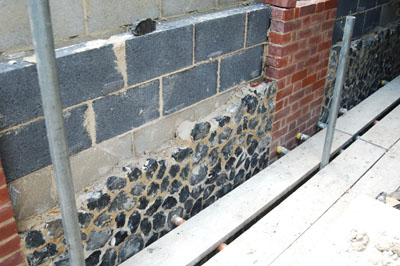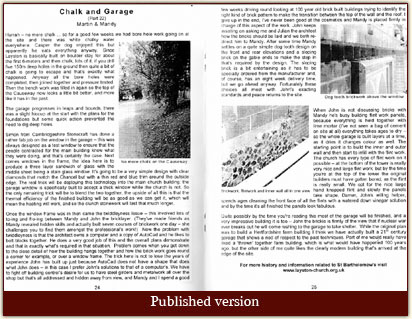Martin & Mandy


Hurrah - no more chalk ... so for a good few weeks we had bore hole work going on at the site and there was white chalky water everywhere, Casper the dog enjoyed this but apparently he eats everything anyway. Since Layston is basically built on boulder clay for about the first 6 meters and then chalk, lots of it, if you drill five 150m deep holes in the ground then quite a bit of chalk is going to escape and that's exactly what happened. Anyway all the bore holes were completed, then joined together and pressure tested. Then the trench work was filled in again so the top of the Causeway now looks a little bit better, and more like it has in the past.
The garage progresses in leaps and bounds, there was a slight hiccup at the start with the plans for the foundations but some quick action prevented the need to dig deep holes.
Simon from Cambridgeshire Stonecraft has done a rather fab job on the window in the garage - this was always designed as a test window to ensure that the people contracted for the main building knew what they were doing, and that's certainly the case. Next comes windows in the frame, the idea here is to produce a three layer sandwich of glass with the middle sheet being a stain glass window. It's going to be a very simple design with clear diamonds that match the Chancel but with a thin red and blue trim around the outside edge. The real trick will be deploying this technology into the main church building; the garage window is specifically built to accept a thick window whilst the church is not. So the only remaining trick will be to blend the two together, the upside of all this is that the thermal efficiency of the finished building will be as good as we can get it, which will mean the heating will work, and so the clunch stonework will last that much longer.
building; the garage window is specifically built to accept a thick window whilst the church is not. So the only remaining trick will be to blend the two together, the upside of all this is that the thermal efficiency of the finished building will be as good as we can get it, which will mean the heating will work, and so the clunch stonework will last that much longer.
Once the window frame was in then came the twiddleyness issue - this involved lots of to-ing and fro-ing between Mandy and John the bricklayer. (They've made friends as Mandy revealed hidden skills and actually built seven courses of brickwork one day - she challenges you to find them amongst the professionals work!) Now the problem with twiddleyness is that the architect owns a computer and a copy of AutoCad and he likes to bolt blocks together. He does a very good job of this and the overall plans demonstrate and that is exactly what's required in that situation. Problem comes when you get down to the close detail of how the building hangs together and how the brick work goes round a corner for example, or over a window frame. The trick here is not to lose the years of experience John has built up just because AutoCad does not have a shape that does what John does - in this case I prefer John's solutions to that of a computers. We have 
to fight off building control's desire for us to have steel girders and metalwork all over the shop but that's all addressed and hidden away from view, and Mandy and I spend a good few weeks driving round looking at 100 year old brick built buildings trying to identify the right kind of brick pattern to make the transition between the top of the wall and the roof. I give up in the end, I've never been good at the cosmetics and Mandy is placed firmly in charge of this aspect of the work. John keeps insisting on asking me and Julian the architect how the bricks should be laid and we both re-direct him to Mandy. After some time Mandy settles on a quite simple dog tooth design on the front and rear elevations and a sloping brick on the gable ends to make the step in that's required by the design. The sloping brick is a bit entertaining as it has to be specially ordered from the manufacturer and, of course, has an eight week delivery time, but we go ahead anyway. Fortunately these choices all meet with John's exacting standards and peace returns to the site.
When John is not discussing bricks with Mandy he's busy building flint work panels, because everything is held together with lime mortar (I've not seen a bag of cement on site at all) everything takes ages to dry - so the whole garage is built layers at a time, as it dries it changes colour as well. The starting point is to build the inner and outer wall and then start to infill with the flint work. The church has every type of flint work on it possible -at the bottom of the tower is really very nice and large flint work, but by the time you're at the top of the tower the original builders must have gotten bored, as the flint is really small. We opt for the nice large hand knapped flint and slowly the panels take shape. Darren, John's willing helper, spends ages cleaning the front face of all the flints with a watered down vinegar solution and by the time it's all finished the panels look fabulous.
to infill with the flint work. The church has every type of flint work on it possible -at the bottom of the tower is really very nice and large flint work, but by the time you're at the top of the tower the original builders must have gotten bored, as the flint is really small. We opt for the nice large hand knapped flint and slowly the panels take shape. Darren, John's willing helper, spends ages cleaning the front face of all the flints with a watered down vinegar solution and by the time it's all finished the panels look fabulous.
Quite possibly by the time you're reading this most of the garage will be finished, and a very impressive building it is too - John the bricky is firmly of the view that if nuclear war ever breaks out he will come rushing to the garage to take shelter. Whilst the original plan was to build a Hertfordshire farm building I think we have actually built a 21st century garage that shows a nod of respect to the past techniques. Part of me would really have liked a 'thrown' together farm building, which is what would have happened 100 years ago, but the other side of me quite likes the clearly modern building that's arrived at the edge of the site.
 |
|
 |
